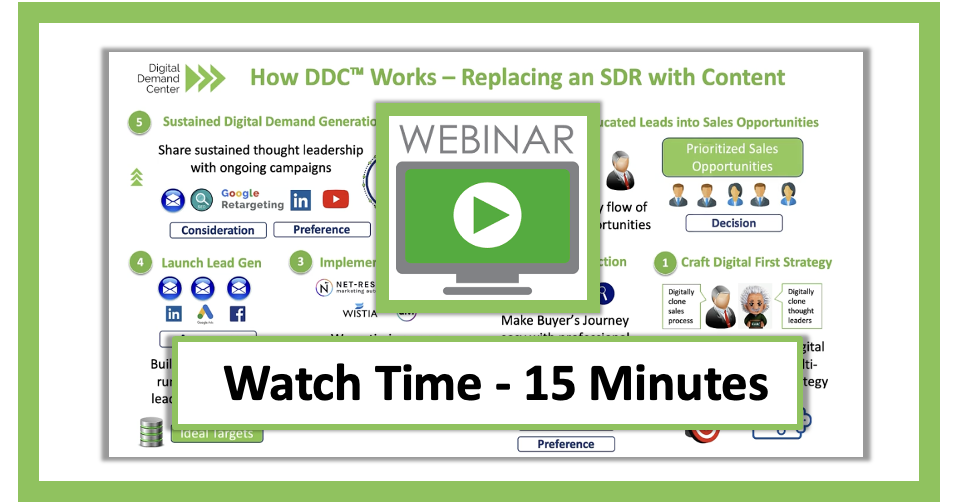
Demand Generation vs Lead Generation
In this video you will learn the difference between lead generation vs. lead nurturing and demand generation
Watch Time – 4:00 Minutes
Summary
This short video is packed with hard data and concrete numbers as we compare Demand Generation vs Lead Generation and explain the strengths and weakness of both a lead generation process and demand generation process. In this educational video we detail:
- The different purposes of lead generation and demand generation
- The results you can expect if you are running a lead generation process
- The results you can expect if you add a lead nurturing and demand generation process
- The impact lead nurturing has on creating well educated sales ready leads and increased conversions
- The cost savings you can expect automating your pre-sales process
This video is an excerpt from The Differences Between Lead Gen vs. Demand Gen and the Impact on Your Sales Funnel Part 4 of 4 of our free comprehensive free 4 training seminar on how to effectively sell to the modern The B2B Digital First Transformation Webinar Series.
Transcript
Defining the Role of Lead Generation and Demand Generation
When you examine the entire sales funnel, Lead Generation is the first step in the sales process and buyer’s journey. Lead Generations job is to move buyers into the top of the sales funnel by creating awareness and curiosity about your solution, and then Demand Generation and Lead Nurturing takeover to automate the pre-sales education process as the buyer goes through their second step of consideration and their third stage of preference.
This process keeps you top of mind as the buyer moves deeper into the funnel and, when the buyer is ready, sales takes over to help them make a decision.
The Stages and Sales Funnel Conversion Results of a Lead Generation Process
Lead Generation is primarily a sales driven process because the seller controls the majority of the buyer education. Marketing or a cold caller targets and generates the lead. The lead is then passed to sales regardless of how ready they are to buy. Then sales invests time, money, and resources with one-on-one pre-sales education, demonstrating the solution, explaining its value, and qualifying that buyer for need, interest, and fit.
After all this time and effort, about 10 to 20% of leads are turned into opportunities and about 80% are either not the right fit or too early in their buying process and not ready to buy. These leads are discarded, with sales promising to follow-up at some future date, which only happens about 20% of the time. This is a continuous cycle requiring a continuous investment in new leads.
The Stages and Sales Funnel Conversion Results of a Demand Generation and Lead Nurturing Process
In sharp contrast to Lead Generation, Demand Generation is a buyer driven process because the buyer engages on their timelines.
A Demand Gen process starts the same way by targeting potential buyers to create awareness and collecting as many leads as possible. But then marketing, not sales, nurtures those leads, sharing educational pre-sales content the buyer can engage with on their timelines.
Demand Generation digitally automates your pre-sales process to make it easy for the lead to consider how your solution can help them solve their problems to become a marketing qualified lead until they learn how your product works and what success looks like so they prefer your solution. While all this is happening, your marketing tech stack is scoring your buyer’s engagement to predict purchase intent until they become a sales ready lead.
The first big difference is pre-sales automation and lead nurturing gets rid of all the time, money, and expense of the one-on-one pre-sales education that’s required in a standalone Lead Gen process.
The second major difference is the quality of sales ready leads. Typically, your sales team can convert about 50% of sales ready leads into opportunities versus the 10 to 20% of a Lead Gen process. Sales will only discard about 10% versus the 80% that are discarded in the Lead Gen process.
A final major difference is that they can recycle 40% back into the Demand Gen engine for extended nurturing to keep them warm until they’re ready to buy. This recycling is a major advantage Demand Generation has over a competitor running a Lead Gen process that discards 80% of their lead investment because most discarded leads buy from someone in three to 18 months so nurturing eventually turns another 25% of these recycled leads into opportunities.
Conclusion
Over time, all these incremental gains stack up, and this is why companies running a Demand Gen process generate 450% more opportunities and close two times the deals over their competitors when compared to companies that don’t.









